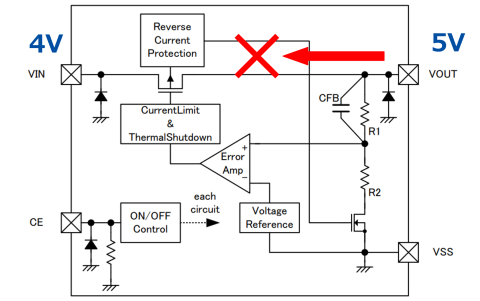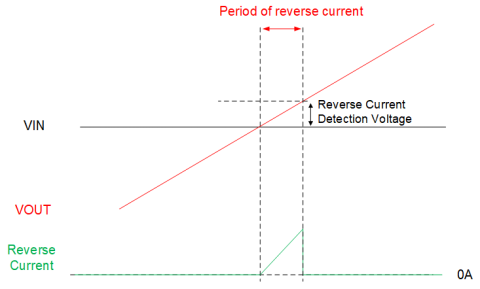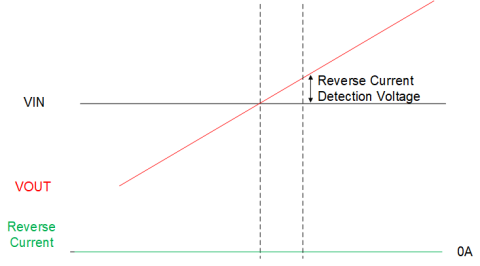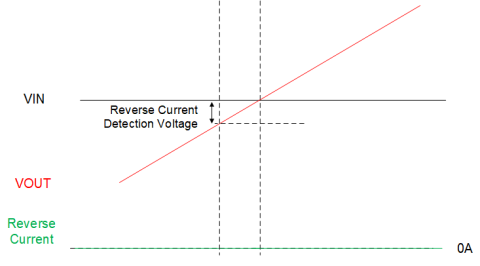The backflow prevention function of load switch IC is a function that prevents backflow of current to input side when the voltage on output side becomes higher than input voltage. It is sometimes mounted on voltage regulator or charger IC, etc. in addition to load switch IC.
Case example that requires the backflow prevention function
1.Preventing the backflow to input wide when voltage higher than input voltage is applied to the output side for Vout "OR" connection.
2.Preventing the backflow from capacitor or power storage device that is connected to output side to input side.
3.Preventing energization of output voltage to input side by cutting off input side and output side when external voltage is applied to output side and the power storage device is connected to output side.


Cautions on backflow prevention function: Backflow may occur even if backflow prevention function is mounted
Although the backflow prevention function seems to prevent backflow from the output side to the input side under any conditions, the current may backflow from output side to input side depending on control system or usage.
For this reason, it is necessary to select a product equipped with appropriate backflow prevention function based on the control system and characteristics of backflow prevention function.
The following explains types and usage of backflow prevention functions.
Types of backflow prevention function: backflow prevention function and complete backflow prevention function
The backflow prevention function is roughly classified into two types.
(1) Backflow prevention function
The backflow prevention function is adopted for general load switch IC, etc.
Only when the switch part of load switch IC is turned OFF, the backflow prevention function surely operates.
With this type of backflow prevention function, whether there is backflow is judged by input voltage becoming lower than output voltage by more than a certain level.
If the input capacity is small or there is no current sinking from input side, the input voltage rises up to output voltage due to backflow current to input side. For this reason, the dropout voltage with which the backflow prevention function operates cannot be ensured and the phenomenon that the backflow prevention function does not work occurs.
As an advantage of this judgment method, when the load switch is turned ON, FET at the switch part can be always fully turned ON and the on-resistance can be reduced.
If the load switch is turned OFF, the input voltage becomes lower than output voltage by more than a certain level before the backflow current flows, so the backflow can be prevented.


(2) Complete backflow prevention function
With this function, the backflow prevention function operates regardless of when the switch part of load switch IC is turned ON and OFF.
With this type of backflow prevention function, the backflow prevention function operates when the output voltage becomes slightly lower than the input voltage.
In this judgment method, the backflow can be prevented even if the switch part of load switch IC is turned ON.
However, when the load switch is turned ON, it is necessary to keep dropout voltage above a certain level in order to prevent the backflow prevention function from malfunctioning. For this reason, voltage drop and conduction loss tend to increase compared to general backflow prevention function.
